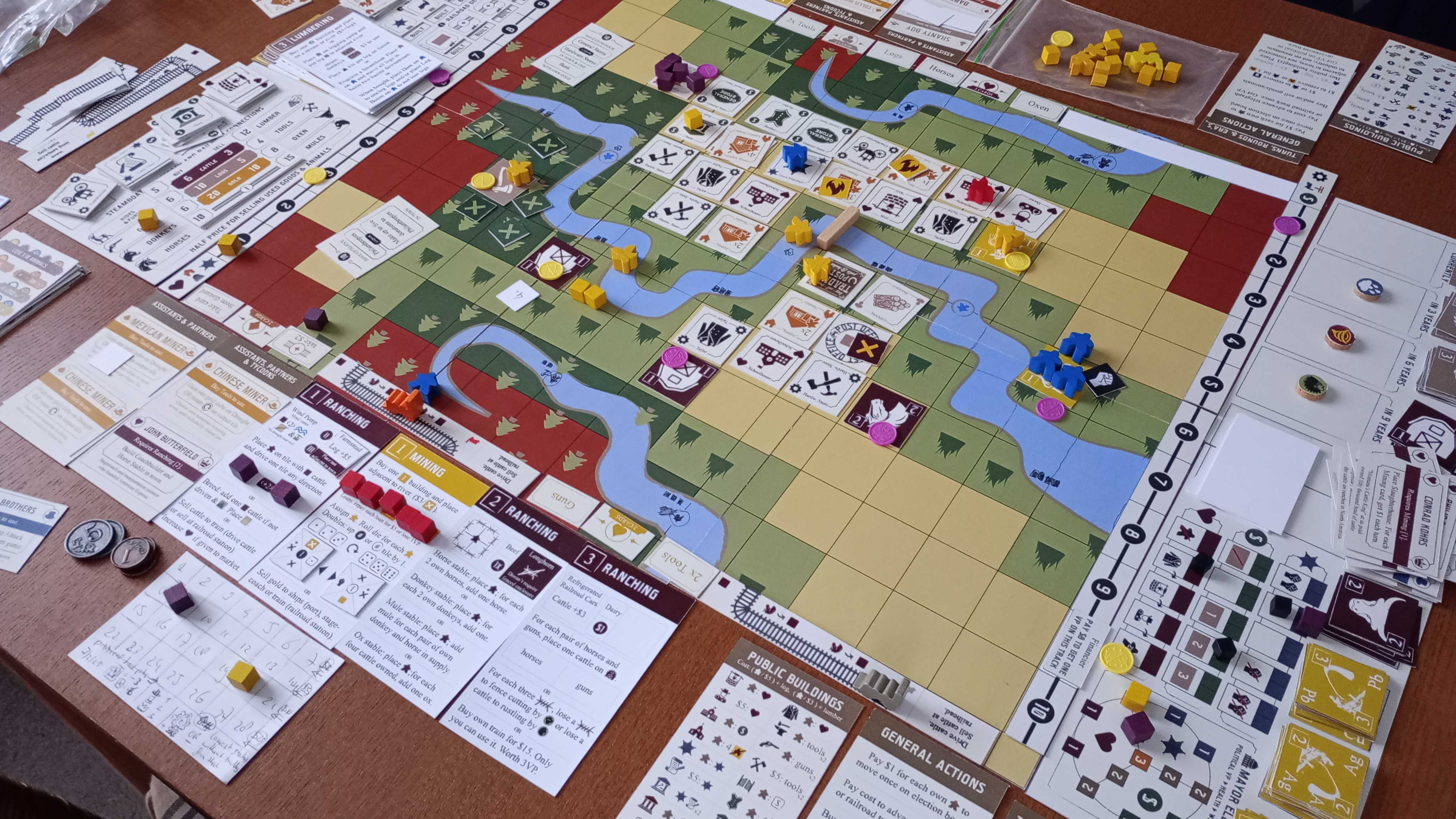

Town building sandbox style board game about the Old West (1850-1900).
Players compete to become a legend of the West, diverging or specializing in one of the three major industries. No duels at high noon, no overload of bounty hunters and lawlessness, as both were contary to the folklore not all that common.
Develop telegraph lines and railroads, attract various workers and influential people from the era to your town to aid in simple production, industry buildings, other development or special buildings.
back to homepageVery first prototype. Created after finding out about the three major industries of the era: mining, ranching and lumbering. I've designed the mechanics to make a cube have a different "meaning" for every industry based on where it is placed.
At first I was looking to build a more "traditional" Wild West theme without the focus on the three major industries. I soon found out about the importance of mining, lumbering and ranching and swapped the current sectors for those.
Despite the three not always necessarily overlapping the same (local) geographical areas, I decided to design the board so it would support all three industries to provide a balanced game no matter how many players would choose which industry.
A board that is quite close to the current version, with an early version of the Ranching and Logging (now lumbering) industry cards at the bottom.
Next to the game board there's two side board at the left and right, which have markets, events, town status and election promises, and railroad and telegraph development.
Again, despite some added restrictions and balance updates, and both overhauled election promises and election system with some changes for the effects of the town status board, the overall layout is largely the same as it was in this first prototype.
Later in the game you can further upgrade your current industry or diverge into another. When upgrading this also follows the actual industries of the time, where each industry plays fundamentally different.
Despite many changes to the game, both the Ranching and Lumbering industries work almost exactly as originally designed, with only minor adjustments and restrictions added.
Where Ranching gives you the opportunity to build stables/liveries and expand to other cattle and dairy breeds, lumbering focuses mostly on more efficiency in harvesting and processing trees, while also giving opportunities to speed up the flow of logs through rivers.
First sketch of the town status effects, turns, general actions and functions of the public buildings. An ongoing dilemma is still whether to allow players to have unlimited or just one general action per turn.
With many of the above again hardly changed and only improved where necessary, the town status card (above, left) has been through more dramatic revisions. Moving from tiles to discs, with every disc now featuring two sides.
With the game being nicknamed "Upkeep Simulator" by myself, there was often more upkeep (involving player choices) than actual gameplay during a round, especially during harder times.
Redesigns went through an absolute horde of changes, from a more deterministic approach to somewhat more input randomness, in the current state it's inbetween those two.
The first version of Mining included tiles for scouting and prospecting. It turned out quickly that this makes it hard to track multiple deposits' progress, and also doesn't reward even having multiple deposits at all.
The only industry that often had some balance problems, finicky rules and thematically unrealistic decisions to be made. Deposits hardly depleted, there was no function for an assay office,
V2 featured loans and later investments.
Even a later system with just one tile as a mitigation/multiplier for die rolls didn't work well enough, solved by limiting early deposits to one worker.
Whenever any of these is developed by players, events or characters, a tile is flipped and the effect immediately activated. Went through a variety of effects, but the five slots are still in the game.
Events feature railroad an telegraph development, inventions, heavy weather and political changes. Plenty of revisions for these. Earlier design had plenty of cards affecting town status, which was removed after it became a luck fest.
(see below, to left) Went from six to eight types of goods. Market cards can be leveled up with railroad and telegraph development, but panic's can lower market cards as well. This causes very different games as prices often make either industries or other investments more lucrative.
Not having higher prices than costs, icons and smaller text frustrating.
The final art still has to be done. Solo playtesting by other players is the last part before this can be done, including finalizing the solo campaign rules.
back to homepage